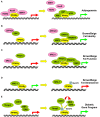Deciphering the Roles of PPARγ in Adipocytes via Dynamic Change of Transcription Complex
- PMID: 30186237
- PMCID: PMC6110914
- DOI: 10.3389/fendo.2018.00473
Deciphering the Roles of PPARγ in Adipocytes via Dynamic Change of Transcription Complex
Abstract
Peroxisome proliferator-activated receptor γ (PPARγ), a ligand-dependent transcription factor highly expressed in adipocytes, is a master regulator of adipogenesis and lipid storage, a central player in thermogenesis and an active modulator of lipid metabolism and insulin sensitivity. As a nuclear receptor governing numerous target genes, its specific signaling transduction relies on elegant transcriptional and post-translational regulations. Notably, in response to different metabolic stimuli, PPARγ recruits various cofactors and forms distinct transcriptional complexes that change dynamically in components and epigenetic modification to ensure specific signal transduction. Clinically, PPARγ activation via its full agonists, thiazolidinediones, has been shown to improve insulin sensitivity and induce browning of white fat, while undesirably induce weight gain, visceral obesity and other adverse effects. Thus, deciphering the combinatorial interactions between PPARγ and its transcriptional partners and their preferential regulatory network in the processes of development, function and senescence of adipocytes would provide us the molecular basis for developing novel partial agonists that promote benefits of PPARγ signaling without detrimental side effects. In this review, we discuss the dynamic components and precise regulatory mechanisms of the PPARγ-cofactors complexes in adipocytes, as well as perspectives in treating metabolic diseases via specific PPARγ signaling.
Keywords: PPAR gamma; adipocytes; metabolic diseases; obesity; transcription complex.
Figures


Similar articles
-
A novel partial agonist of peroxisome proliferator-activated receptor-gamma (PPARgamma) recruits PPARgamma-coactivator-1alpha, prevents triglyceride accumulation, and potentiates insulin signaling in vitro.Mol Endocrinol. 2006 Apr;20(4):809-30. doi: 10.1210/me.2005-0171. Epub 2005 Dec 22. Mol Endocrinol. 2006. PMID: 16373399
-
Distinct properties and advantages of a novel peroxisome proliferator-activated protein [gamma] selective modulator.Mol Endocrinol. 2003 Apr;17(4):662-76. doi: 10.1210/me.2002-0217. Epub 2003 Jan 16. Mol Endocrinol. 2003. PMID: 12554792
-
A selective peroxisome proliferator-activated receptor-gamma (PPARgamma) modulator blocks adipocyte differentiation but stimulates glucose uptake in 3T3-L1 adipocytes.Mol Endocrinol. 2000 Sep;14(9):1425-33. doi: 10.1210/mend.14.9.0528. Mol Endocrinol. 2000. PMID: 10976920
-
Transcriptional Regulation of Adipogenesis.Compr Physiol. 2017 Mar 16;7(2):635-674. doi: 10.1002/cphy.c160022. Compr Physiol. 2017. PMID: 28333384 Review.
-
Peroxisome Proliferator-Activated Receptor Gamma (PPARγ) as a Target for Concurrent Management of Diabetes and Obesity-Related Cancer.Curr Pharm Des. 2017;23(25):3677-3688. doi: 10.2174/1381612823666170704125104. Curr Pharm Des. 2017. PMID: 28677503 Review.
Cited by
-
Pinostrobin: An Adipogenic Suppressor from Fingerroot (Boesenbergia rotunda) and Its Possible Mechanisms.Foods. 2022 Sep 29;11(19):3024. doi: 10.3390/foods11193024. Foods. 2022. PMID: 36230099 Free PMC article.
-
Dissecting the Gene Expression Networks Associated with Variations in the Major Components of the Fatty Acid Semimembranosus Muscle Profile in Large White Heavy Pigs.Animals (Basel). 2021 Feb 27;11(3):628. doi: 10.3390/ani11030628. Animals (Basel). 2021. PMID: 33673460 Free PMC article.
-
Browning of the white adipose tissue regulation: new insights into nutritional and metabolic relevance in health and diseases.Nutr Metab (Lond). 2022 Sep 6;19(1):61. doi: 10.1186/s12986-022-00694-0. Nutr Metab (Lond). 2022. PMID: 36068578 Free PMC article. Review.
-
Amphiphilic cytokine traps remodel marrow adipose tissue for hematopoietic microenvironment amelioration.Bioact Mater. 2024 Sep 3;42:226-240. doi: 10.1016/j.bioactmat.2024.08.032. eCollection 2024 Dec. Bioact Mater. 2024. PMID: 39285915 Free PMC article.
-
Black Ginseng and Ginsenoside Rb1 Promote Browning by Inducing UCP1 Expression in 3T3-L1 and Primary White Adipocytes.Nutrients. 2019 Nov 12;11(11):2747. doi: 10.3390/nu11112747. Nutrients. 2019. PMID: 31726767 Free PMC article.
References
-
- McCormack S, Polyak E, Ostrovsky J, Dingley SD, Rao M, Kwon YJ, et al. . Pharmacologic targeting of sirtuin and PPAR signaling improves longevity and mitochondrial physiology in respiratory chain complex I mutant Caenorhabditis elegans. Mitochondrion (2015) 22:45–59. 10.1016/j.mito.2015.02.005 - DOI - PMC - PubMed
Publication types
LinkOut - more resources
Full Text Sources
Other Literature Sources
Research Materials

